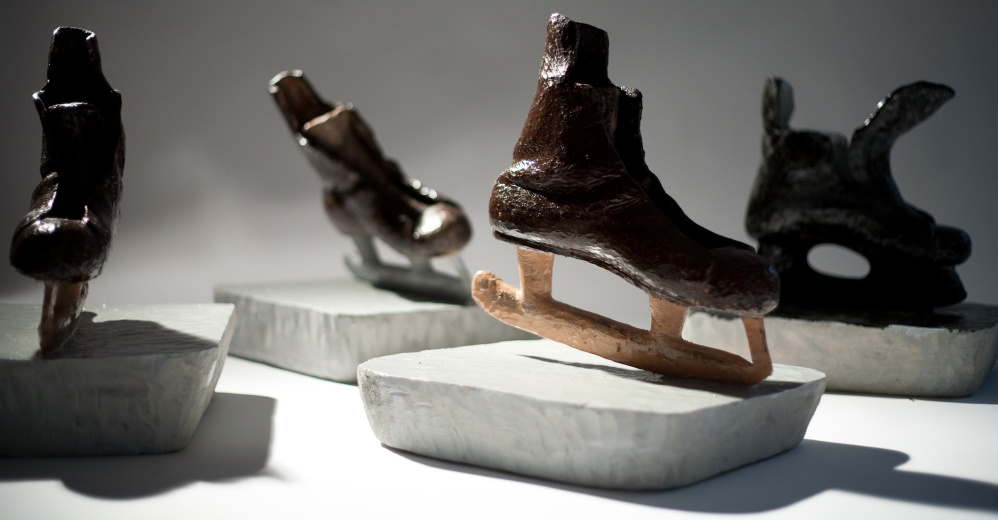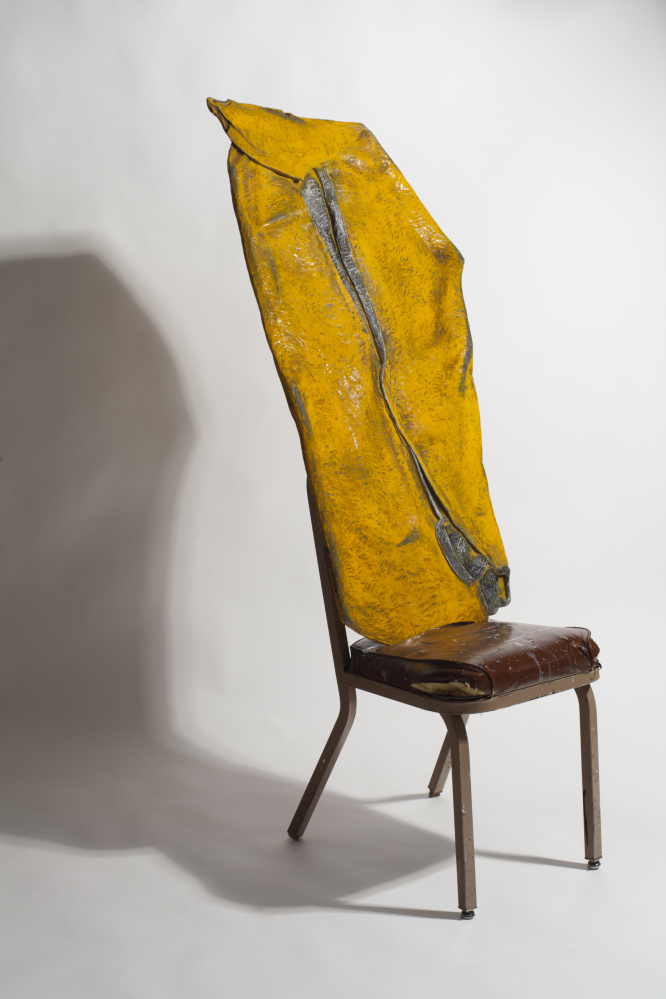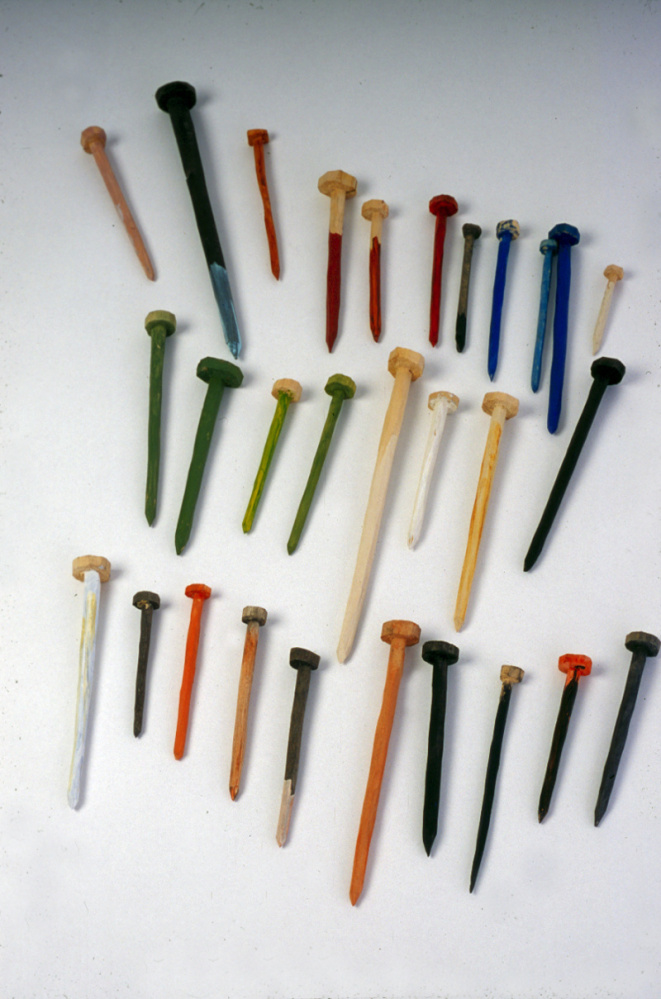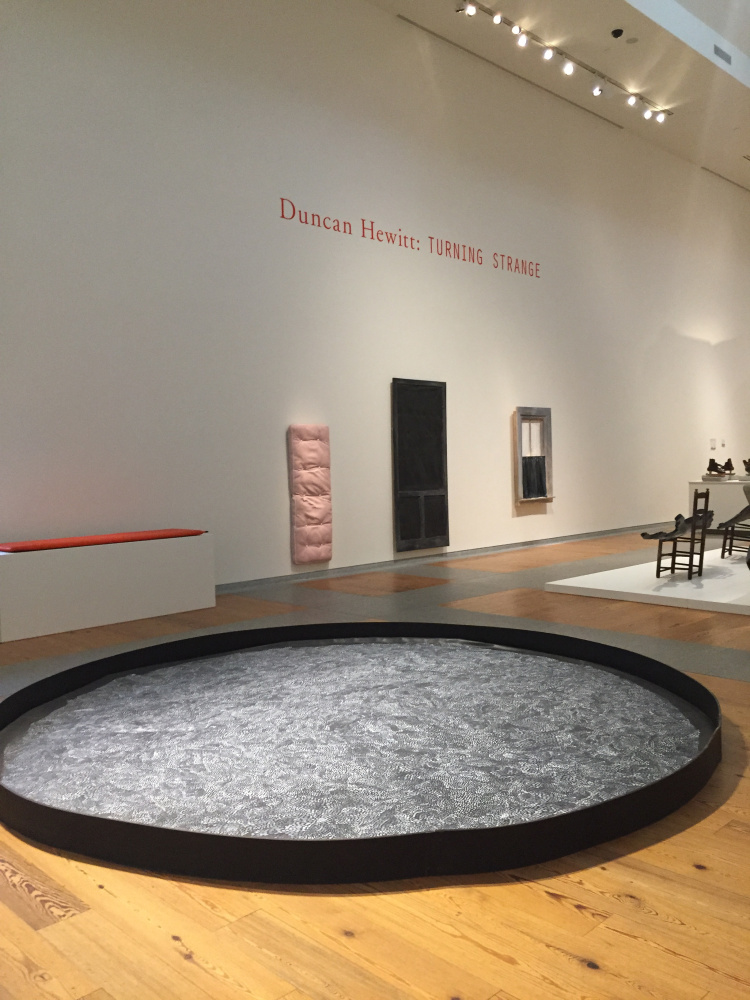Duncan Hewitt’s excellent Circa series exhibition “Turning Strange” at the Portland Museum of Art features several dozen objects: ice skates, balaclavas, mattresses, nails, windshields, fire screens, bicycle tire tubes, pot lids, a door, a curtained window, stacked brushes, a wading pool, lollipops and more.
Everything in the show is made of carved and painted wood, except the huge black rubber wading pool which is most notable for playing its part in a vast, conspiratorial witticism: Hanging on the wall next to the rubber pool is a three-by-eight grid of carved wooden bicycle tire tubes, four of which are folded over on the top row, giving the series a rather calendar-like sense of time. But they are faux-rubber objects hiding in plain sight next to a giant, tire-shaped, actual-rubber vessel that only contains painted dots playing the part of simulated water droplets.
The wall texts say the objects garner their true meanings through Hewitt’s “emotional processing” and invite viewers, likewise, to find their own personal meanings. But it is a lame discourse about nostalgia. It’s like inviting small children over for some rousing parallel play.
Given the space (which we don’t have), interpreting each of Hewitt’s pieces on its own is interesting. He has a poetic sense and a talent for creating intriguingly enigmatic objects, but anyone can savor Hewitt’s tantalizingly just-out-of-focus poetics on their own. A bigger picture perspective, however, pays off with broader insights about contemporary art and culture.
By definition and practice, conceptual art is predicated on an idea; consequently, the execution of its vessel – the art object – is essentially perfunctory. Craft, on the other hand, has generally been predicated on working in a specific medium – like wood.
Hewitt is usually represented as a sculptor, but if we define sculpture as mostly three-dimensional form, we miss some big stuff in “Turning Strange.” For starters, every object in the show is a vessel – and vessels are the stars of the craft realm.
Hewitt’s skates are vessels for feet and his hats hold heads. The inflatable tubes and mattresses hold air. His standing fire screens imply the wood that has been carved away. The windshields close in the space for people in cars. And even the chairs that hold up the windshields are vessels for people. The pot lids are pretty obvious (tool-marked like they were banged by kids wielding drumsticks), as are the collapsed metal forms that look like funny-faux John Chamberlain works: Hewitt, hilariously, represents the crushed-metal Chamberlain sculpture, in carved wood – giving craft the final (and postmodern) word.
While the general idea is what matters, getting caught in the outliers is interesting: Hewitt’s nails are being used as vessels for color – the piece is called “Color Test (29 nails),” the three rear-view mirrors are vessel frames for the hand-formed metal mirror-proxies, Hewitt’s fascination with the screen door lies in the volumes created by the old bent mesh, the window announces the vessel-like interiority of Hewitt’s own house, and even the maps that evolve out of the windshields present Long Island as a thing with people in it. While some mattresses contain air, the pink one hung on the wall (I have to wonder if that presentation was Hewitt’s idea – it lessens the piece by riding too much on Robert Rauschenberg) contains the textured softness of stuffing. Hewitt’s approach follows a loose realism (sprezzatura) that comfortably incorporates the qualities of the wood and the tool marks. One way or another, Hewitt’s works are vessels, all.
Hewitt is making a powerful argument that vessels – and therefore craft – have a fundamental, even transformational, connection with people. We live in vessels. They clothe us. They protect us. They feed us. And they help us play.
Even Hewitt’s most insular bits of wit can open up broadly: Wooden spoons are typically the first assignment for woodcarving students, and he pushes right past that with two carved forks in a bag. The pair implies a dinner for two, therefore a table and therefore an interior space and, of course, two people dining together: one fork for Hewitt and the other for you, the viewer – his guest.
I was particularly moved by how the paint of the red air mattress makes the viewer see the wood-colored mattresses as another color; if the red work weren’t there, the sense of wood would take center stage. The red thus becomes the camouflage for a different object – like a bait and switch.
One of the most significant recent shifts in American visual art has been an increasing emphasis on the role of the object in process and concept-oriented art. This move, in part, is an acknowledgment of the ascendancy of fine craft (I maintain glass impresario Dale Chihuly is the most popular artist in America) as well as the art audience’s call for well-made objects. Whether you see craft as rising to the level of art or art as appropriately humbling itself to the level of craft, what matters here is that Hewitt is effectively melding the pair in the same bowl of transcendent stew.
The most powerfully enigmatic piece in “Turning Strange” is “Under Mask” – a carved balaclava duct-taped to the back of a standing, painted piece of glass leaned against the wall. The textured white paint serves to make a window, gives the work an icy feel and casts a beautiful shadow painting on the wall. It is a rich blend of craft, artistic symbolism and critical theory ideas with intentionally impenetrable emotional content and the sense of being inspired by personal narrative. My guess is the duct tape was a happy studio accident that unleashed a wave of unintended impact; but does intention matter? Maybe we invest too much in the idea the artist knows the truth and we are only ever catching up, when in fact we get to see art unfold over time in culture in ways artists can’t. And isn’t it the curators who create context?
We generally think of art as being about skill-scribed content while craft is about objects’ transcending their humble physicality. In this sense, too, Hewitt gravitates towards the alchemy of craft. That is not to say Hewitt devalues content. The show title “Turning Strange” is taken from Alice Munro’s short story “Walker Brothers Cowboy,” and its focus on the perceptual otherness of dusk, that transformative moment between night and day. The easy read is that Hewitt transforms his materials into objects that then transform themselves into symbols, metaphors and so on. However, Hewitt’s most significant achievement is the way in which he illuminates the increasingly dusky space between craft and art, a now-soft boundary that is dissolving even (or maybe especially) at its highest points.
Freelance writer Daniel Kany is an art historian who lives in Cumberland. He can be contacted at:
dankany@gmail.com
Copy the Story LinkSend questions/comments to the editors.






Success. Please wait for the page to reload. If the page does not reload within 5 seconds, please refresh the page.
Enter your email and password to access comments.
Hi, to comment on stories you must . This profile is in addition to your subscription and website login.
Already have a commenting profile? .
Invalid username/password.
Please check your email to confirm and complete your registration.
Only subscribers are eligible to post comments. Please subscribe or login first for digital access. Here’s why.
Use the form below to reset your password. When you've submitted your account email, we will send an email with a reset code.